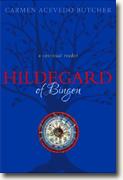Hildegard of Bingen
Carmen Avecedo Butcher
book reviews:
· general fiction
· chick lit/romance
· sci-fi/fantasy
· graphic novels
· nonfiction
· audio books
· author interviews
· children's books @
curledupkids.com
· DVD reviews @
curledupdvd.com
newsletter
win books
buy online
links
home
for authors
& publishers
for reviewers

 |
Hildegard of Bingen: A Spiritual Reader Carmen Avecedo Butcher Paraclete Press Paperback 220 pages March 2007 |
|
If the Pope were to look for another woman saint to be named as a Doctor of the Church, St. Hildegard of Bingen would be a great candidate. A Benedictine abbess of two monasteries of nuns in Germany near the Rhine River, St. Hildegard lived from 1098 to 1179 - during the time of the great Doctor of the Church, St. Bernard of Clarivaux, also a follower of the Rule of St. Benedict.
St. Hildegard had many visions which Church authorities ordered her to write down. She did not rely on herself, fearing she might be deceived by the devil, but always discussed the visions with her confessor, who was a Benedictine monk. St. Hildegard most likely experienced severe migraines, yet she was able to learn about theology, nature, medicines and philosophy. She wrote music and plays; indeed, she was one of the early writers of morality plays. Because of her holiness, nobles and peasants alike sought St. Hildegard’s advice. High churchmen, like Pope Eugene III, sought her advice and encouraged her preaching. He read part of her visions at a synod meeting of bishops he was attending. She stood up to Frederick Barbarossa, the Holy Roman Emperor who was challenging the Church’s authority. St. Hildegard lived to be 81 years old, unusual for people in those days. She was not canonized by the Church through the canonization process that we know of, but acclaimed a saint by all of the people of God. Her feast day is September 17th. Carmen Acevedo Butcher has translated Hildegard’s words into this modern English reader that even teenagers and young adults can relate to. Prior to the seven chapters comprising the reader is a short biography of St. Hildegard. At the beginning of each chapter, Butcher provides an introduction to the work she is translating. She provides examples from Hildegard’s songs in chapter one; some of these songs have been put to music and are available as CDs, and Butcher provides a list of these in her bibliography. Hildegard’s songs (in Latin) are very moving and mesmerizing to hear, and she created her own musical notation. In chapter two, Butcher provides examples from Hildegard’s theological work Scivias, “a very orthodox handbook for good Christian living.” Hildegard follows the example of St. Augustine, according to Butcher. In chapter three, Butcher presents Hildegard’s The Play of Virtues, a morality play acted out by Hildegard’s nuns in the 11th and 12th centuries, before the popularity of morality plays in the 14th century. She was ahead of her times with her play about the devil trying to seduce a soul and how the virtues try to help the soul against the devil. In chapter four, Butcher provides some selections from Hildegard’s letters to various people. Chapter five showcases examples from Physica and Causes and Cures, books that Hildegard wrote about medicine and health. She gives remedies for overeating, uses of garlic and apples, and other medical aids. Chapter six is on The Book of Life’s Merits, which is about Hildegard’s visions “on the temptations every Christian encounters and how God can help.” She presents vices and their counter-virtues to show how one should live. Chapter seven is on another work of theology, The Book of Divine Works, which is about God’s love for humanity and for creation. Butcher provides two appendices, the first being a chronology of Hildegard’s life and the second a bibliography of her works, those about her, and a list of the recordings of her music. Carmen Butcher writes with a down-to-earth style that speaks to modernists or post-modernists the works of St. Hildegard. She also provides great introductions to the various works of the saint. Too bad St. Hildegard’s commentary on the Rule of St. Benedict was not included, although some quotes are. This work is highly recommended to those interested in the works of St. Hildegard of Bingen or those interested in Benedictine spirituality. This reader will speak to the soul; the person reading it just has to listen. Originally published on Curled Up With A Good Book at www.curledup.com. © Br. Benet Exton, O.S.B., 2007 |
| Also by Carmen Acevedo Butcher: |
|
|
|
 Click here to learn more about this month's sponsor! |
|
| fiction · sf/f · comic books · nonfiction · audio newsletter · free book contest · buy books online review index · links · · authors & publishers reviewers |
|
| site by ELBO Computing Resources, Inc. | |
 St. Hildegard was a great mystic and preacher, unusual in that she publicly preached to clergy and laypeople when this was an unusual occurrence. She was not a rebel speaking against the Church but rather a firm believer who had permission from the Pope and bishops to preach to build up and encourage all Christians, no matter their rank in society, to live as good Christians.
St. Hildegard was a great mystic and preacher, unusual in that she publicly preached to clergy and laypeople when this was an unusual occurrence. She was not a rebel speaking against the Church but rather a firm believer who had permission from the Pope and bishops to preach to build up and encourage all Christians, no matter their rank in society, to live as good Christians.